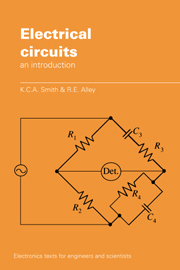Book contents
- Frontmatter
- Contents
- Program listings
- Preface
- 1 Basic concepts, units, and laws of circuit theory
- 2 Theorems and techniques of linear circuit analysis
- 3 Alternating current circuits
- 4 Power and transformers in single-phase circuits
- 5 Three-phase alternating current circuits
- 6 Transient and steady-state analysis
- 7 Non-linear circuit analysis
- 8 Two-port networks
- Appendices
- Bibliography
- Answers to problems
- Index
2 - Theorems and techniques of linear circuit analysis
Published online by Cambridge University Press: 05 June 2012
- Frontmatter
- Contents
- Program listings
- Preface
- 1 Basic concepts, units, and laws of circuit theory
- 2 Theorems and techniques of linear circuit analysis
- 3 Alternating current circuits
- 4 Power and transformers in single-phase circuits
- 5 Three-phase alternating current circuits
- 6 Transient and steady-state analysis
- 7 Non-linear circuit analysis
- 8 Two-port networks
- Appendices
- Bibliography
- Answers to problems
- Index
Summary
Introduction
By making the assumption that all of the elements in a circuit are linear, the analysis is greatly simplified. Although all real circuits are nonlinear to some degree, in most cases a linear treatment gives sufficiently accurate results, and even for circuits containing highly non-linear elements, methods can often be devised for dealing with them on a linear basis. It is for these reasons that the study of linear circuit theory is of paramount importance in electrical engineering science.
The theorems and techniques of linear circuit analysis presented in this chapter, while being of general usefulness and validity, are developed in the context of d.c. circuits. The advantages of this approach are twofold: firstly, the theory can be developed on the simplest possible basis and in terms which will be familiar to most students. Secondly, the study of d.c. circuit theory is of great practical importance in its own right since it arises in many branches of power and electronic systems analysis.
D.C. linear circuits comprise assemblies of linear lumped resistances together with ideal direct voltage and current sources. The theory appertaining to such idealized circuits is concerned with real situations since many types of source found in practice, a battery for example, can be represented to a good approximation by an ideal source in combination with a lumped resistance.
A typical voltage-current characteristic, or load characteristic, for a practical voltage source is shown in fig. 2.1.(b).
- Type
- Chapter
- Information
- Electrical CircuitsAn Introduction, pp. 42 - 97Publisher: Cambridge University PressPrint publication year: 1992



